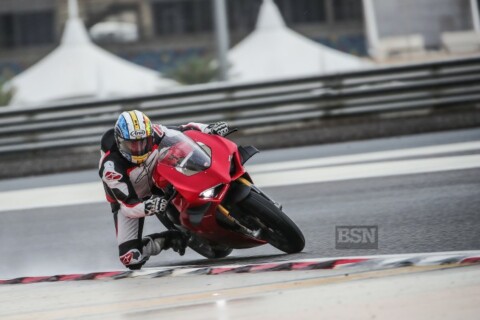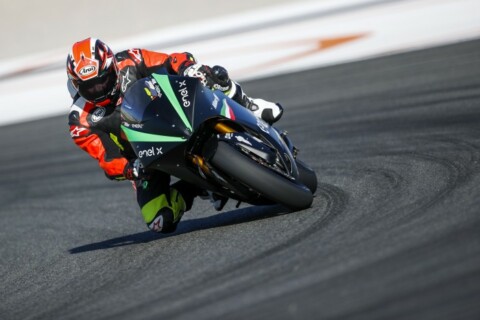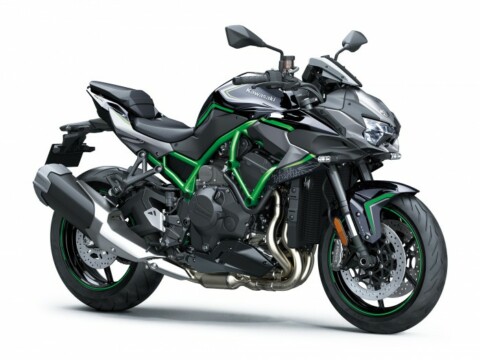If someone, pre-Panigale, said Ducati would be bereft of a World Superbike title after its 90s and early Noughties dominance, you would have laughed them out the room. But entering 2015, the Bologna factory hasn’t won a championship since Carlos Checa’s swansong in 2011 onboard the 1198.
There’s no hiding from the fact the Panigale has suffered with its idiosyncrasies in WSBK spec. New rules for this season should benefit Ducati, and Chaz and Dave should no longer be losing three or four tenths on every straight.
Meanwhile, back in the real world, seeing as most who compete on a Panigale opt for the full-fat R version, Ducati has decided to reinstate some of that trademark midrange for trackdayers and road-based customers, and sway outside the box a little. Ladies and gents: we give you the 1299 Panigale.
Just hours after the Corse squad had completed their testing schedule at Portimao, we arrived at the same circuit to sample the S version. The Bologna factory admits midrange was missing from the 1199’s Superquadro engine, especially in bog-standard form.
Rather than overwork the existing components and risk fragility, the 1299 gets a capacity increase to 1285cc for a massively over-square ratio. As if the largest piston diameter in the world wasn’t enough, Ducati engineers have increased bore from 112mm to 116mm, which means the Panigale joins the 200bhp club – the must-have membership of 2015. Claimed peak power is 10bhp up on the 1199 and 15-18% beefier in other parts of the rev range, with 10% extra torque: 144.6Nm @ 8,750rpm.
Another must-have contraption this season is an IMU (inertial Measurement Unit), which measures the 1299’s roll and pitch before supplying relevant riding aids. Essentially, it’s a three-axis gyro used to calculate dynamics for traction control, Bosch’s Cornering ABS and, the crème de a crème, Öhlins Smart EC suspension.
Powered by stepper motors, this is Öhlins’/Ducati’s answer to Sachs’/BMW’s semi-active suspension. Rather than constantly adjusting damping in response to surface change and environment - a la BMW - this Öhlins trickery inside the impressive NIX30 fork and TTX shock is ‘event-based’, meaning damping is stiffened under braking and acceleration, and softened at the apex where you want feel from the front-end.
There’s also a ‘Fixed’ setting, but that means painfully toggling through the menu on the dash to manually adjust set-up. If you’re interested, the standard 1299 Panigale comes with the usual Marzocchi/Sachs suspension.
Costing over £20k, there’s a medley of electronics to please racers and trackdayers alike. Ducati’s 8-level anti-wheelie system is pinched from the Superleggera, and an auto-blipper ensures the clutch is redundant other than leaving pit lane: Chaz and Dave only received such delicacies halfway through 2014, so it gives you some idea of how fresh the technology is.
Back in Blighty, the Panigale hasn’t had the modest success that it has in Europe. Historically, the Panigale doesn’t gel with UK circuits, suiting the wider, flatter GP-style layouts. Watching Tristan Palmer trying to calm the 1199 Panigale at Knockhill was pure entertainment, in a kind of masochistic sense.
Rake has been reduced from 24.5° to 24° and trail has been shortened from 100mm to 96mm. The swingarm pivot is 4mm lower to improve rear grip – an idea pilfered from the old R model – as some Panigale racers in the BSB paddock were known to have installed lead weights in the seat unit, in a bid to improve exit speed and stability. It worked (a bit).
The chassis tweaks give a 52%/48% balance in favour of the front and a diet sees the 1299 kiss the scales at just 166.5kg in dry form: the lightest production superbike on the market.
So what’s it like? Samey looks, subtle aesthetic tweaks aside, even before leaving Portimao’s pit lane, some of the chassis balance tweaks are palpable. The 1299 feels instantly lower at the back, with a less menacing stance.
After Portimao’s awkward downhill hairpin (home of Guintoli and Melandri’s kerfuffle last season), the long sweeping drive back up the hill highlighted just how much more mechanical grip is on offer with the 1299. There’s more confidence to maintain 100% throttle without it feeling like a suicide mission, as stability under hard acceleration is also substantially improved – no more shock pumping for 2015.
And Öhlins has to take some credit for this. Without riding a conventionally sprung bike, it’s impossible to understand the ratio for responsibility, although you can feel the shock playing a supporting role on the gas.
Portimao’s first turn is deceptively challenging. Top gear, edging 180mph, the world drops away as the brakes are slammed on, while your breakfast threatens to reappear. There’s no way you could get away with this on the 1199.
The mix of mechanical and electrical upgrades fighting natural forces, as the 1299 remains glued to the Tarmac. Talking of brakes, the Bosch Cornering ABS is definitely a safety feature for the road, and not a performance enhancer. The technology isn’t intuitive enough (yet) to make a breakthrough on race bikes.
The stability hasn’t sacrificed steering speed or flickability. In fact, the 1299 is more nimble and willing to be bossed to the apex than ever before, changing direction with a whiff of handlebar. From sixth gear down to third via the incredibly precise auto-blipper, there’s enough weight transfer under heavy braking for concise corner entry and caressing the front towards the apex.
Simultaneously, the Öhlins provides a bed of stability that makes the 1199 look positively dangerous, and maintains connection and confidence on brake release that other semi-active systems (BMW) can’t provide.
The unique monocoque manners and flexless feeling of the 1199 have been slightly diluted in 1299 guise. It feels softer and more forgiving at any time over a lap, particularly the front–end, and less likely to throw shapes. On the absolute limit, there’s always that sensation of the rear wanting to overtake the front in a typical Panigale way, but its epic fun.
Not surprisingly, it doesn’t take long to indulge in the 1299’s extra grunt. It was wheelying manically as fourth gear was clicked over any excuse for a crest – and there are a few of them at Portimao.
Ducati’s Wheelie Control (DWC) was a blessing in the Algarve. Although far from unrideable without the system intruding, a subtle trim in power ensures the front never threatens to go AWOL. The system is present to tame the 1299’s extra oomph, rather than prevent the front looping over crests.
Only the more intrusive settings enticed the nose back down and more experienced riders could outperform the electronics’ unpredictability with some good old rear brake control.
Having pinched the Superleggera’s switchgear, the 1299 now has practical real-time adjustability to make you faster on track, very much like the Aprilia RSV4’s toggle buttons. Engine braking, traction control and anti-wheelie settings can all be changed in a split second thanks to the buttons. Some of the slower corners required more engine braking, as the 1299 was running on a little too much for my liking (and everyone else’s). On the contrary, it liked less engine braking for the faster sections, allowing its new love for extra corner speed to blossom.
As well as losing out on power, the race bikes have struggled with sidegrip since the Panigale’s inception. With mechanical grip improved, the 1299’s Superquadro motor insistence on a banzai delivery and the way in which, internally, it spins so quickly, makes life difficult on when you spend long periods of time on the sidewall.
Other than an old two-stroke, I’m struggling to think of a more violent engine. The 1199’s powerband has been replaced with a chunkier midrange but it’s still a rampant animal, and noticeably faster than its predecessor. It picks up with more vigour at any part of the range, like there’s nothing inside those magnesium cases.
Given the refinement of Ducati’s ride-by-wire technology, it’s a friendly old animal. And with a wide scope for mechanical and electrical customisation, through various riding modes and endless combinations, there’s a set-up installed somewhere in the 1299 to suit most riders and environments. It’s just a shame you can’t race it…
Unless you’re racing in EMRA’s Open 1300cc event or generous Sound of Thunder classes, the 1299 wont be a paddock regular. Overall, though, the 1299 beats the 1199 in every performance segment. It’s faster, easier to ride and exploit the limits, and it’s general handling capabilities have been broadened. Only one journo crashed, but he was riding like a 12 year old who’d just been offered a GP contract. There’s no doubt the Panigale is still a handful, and far more physical than any other production bike - you certainly know you’ve done 10 laps.
The problem for the majority of us is its £20k price tag. Then again, it’s one of the most technologically advanced pieces of rolling metallic beauty ever created. And even with its additional power and ability, will it have the outright pace of rivals? Questionable, although there isn’t anything on the market that’s more involving.
Click here for the launch gallery
Read the full, five-page test in Thursday’s issue of Bikesport News










